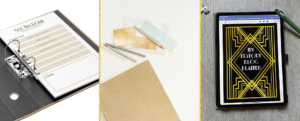From holding a letter written by Elizabeth I to wishing she could have seen The Anglo-Saxon Chronicle penned in 890, Dominique’s love of historical sources and archiving shines through her posts. So, when it came to giving you some history blogging research tips, (a part of blogging which can sometimes feel overwhelming) she was top of my list. Enjoy learning about her love of history, get some research tips + check out the links below to access her great free resources too : )
Q1: Hi Dominique, let everyone know what your blog is about, who it’s for and why it’s called Some Sources Say?
A: Hi Elizabeth, Some Sources Say is a general history blog where each month I choose a designated history topic covering an interesting person, place or event.
I’m particularly interested in women’s history and medieval/early modern Europe so these feature heavily in my monthly themes! I create a mixture of articles, recommendations and Snapshot of History videos as well as free guides with advice and tips for conducting historical research.
My blog is for anyone with an interest in history and you don’t need any prior knowledge to enjoy the content.
My blog was originally called The History Grad, but a few years ago I felt like I had outgrown this name and re-branded to Some Sources Say, as I’m inspired by original records and utilise these resources as often as I can.
Q2: What made you focus on women’s history and medieval/early modern Europe?
A: At school I learnt about whatever topic we were given, but at university where I got the option to choose, I found myself gravitating towards women’s history and medieval/early modern Europe. This culminated in my dissertation ‘The monstrous empire of a cruell woman’ – To what extent did sixteenth century views of women, in France, England and Scotland, define royal women’s ability to wield political power? which combined my interests!
After leaving university I didn’t want to give up researching and writing, even though I didn’t wish to pursue a career in academia. Some Sources Say has given me the freedom to continue exploring these topics and write about things that interest me (and hopefully readers!)
Q3: When was the moment you became a lover of history?
A: I became a history lover when I was a kid and discovered the fascinating world of the Tudors. I remember reading Horrible Histories books like The Terrible Tudors and Cruel Kings and Mean Queens and being riveted by the complex life of Henry VIII and his six wives.
We lived in Berkshire when I was younger, and my family took me to visit the Tower of London and Hampton Court Palace, which are key sites associated with this dynasty. Walking where Anne Boleyn and other key Tudor figures once stood was incredibly cool, and ever since I’ve been fascinated by stories from the past.
Q4: If you could go back in time and see an historical source being created live what would it be and why?
A: It’s so hard to choose, however, I think it would have to be the Anglo-Saxon Chronicle when it was being originally compiled during the reign of Alfred the Great in around 890. This Chronicle was the first systematic attempt to chronicle events in England, and is an amazing resource for historians. I have an edited and translated copy in my ever-growing reference library, which I used a lot for this year’s 1066 content!
Q5: What’s the most fascinating primary source you’ve ever had in front of you?
A: The York Gospels which I had the privilege of being able to hold whilst working at York Minster a few years ago. This manuscript is over 1000 years old and is one of the only surviving gospel manuscripts dated pre-Conquest. It may not be as showy and illuminated as other medieval manuscripts, but it is beautiful and being able to hold it was incredible. Other highlights for me include Shakespeare’s First Folio and a letter signed by Elizabeth I!
Q6: What do you love the most about looking through archives?
A: What I love most about looking through archival records is how it connects me to history. Archives are such amazing resources which hold our heritage and having an archival record in my hands creates a tangible link from me to the past. History for me really comes alive when I’m looking at records, especially letters and correspondence.
Research Tips
Q7: What advice would you give someone who wants to write about history but doesn’t know where to start finding sources?
A: Once you know the topic you want to write about, I would recommend starting with a basic internet search to see what comes up. This should highlight online resources or books that would be key to view for your topic. I have created a Top 10 Sources Guide on my blog which highlights some key resources I use, which is another place you can start.
Q8: What’s your top tip for any history blogger getting overwhelmed by research?
A: If you’re beginning to get overwhelmed by research my top tip would be to take a break. Sometimes if you’re reading lots of content for your research your head can feel overwhelmed with information. It’s worth stepping away and having a cup of tea, giving your ideas time to settle and weave together.
Sometimes the sheer number of resources can in itself be overwhelming, but remember you won’t be able to read everything created about your topic, so it’s important to pick your sources wisely when researching.
Q9: Where do you look for history-related images to use on in your blog posts?
A: I use Wikimedia Commons which is a fantastic resource! It’s where I find the majority of images I use. They are free to reproduce although you have to remember to attribute them to the image creator where applicable. I also use a lot of my own photographs, especially for blog posts recommending heritage sites I’ve visited.
Q10: What’s your top tip for searching online archive sites?
A: My top tip for searching an archive website is to spend a bit of time familiarising yourself with it. There can be a lot of information to absorb in terms of how to access records as well as their online catalogue (if they have one).
Archive websites can be quite different from one another, and will include varying degrees of information. If you do get stuck using a website and can’t find the information you’re looking for, then contact the archive in question directly. If you’re new to archives you can check out my Archives for Beginners guide on my website.
Q11: What does the future have in store for Some Sources Say and how can people connect with you?
A: This Autumn I’m going to be producing lots of exciting content about the Angevin dynasty, as well as looking ahead and brainstorming history topics for 2022! You can visit my blog site here to find all my articles, recommendations, guides and videos. If you have any questions about Some Sources Say you can contact me on social media or at somesourcesay@gmail.com.




